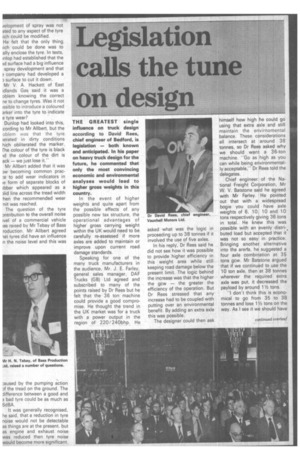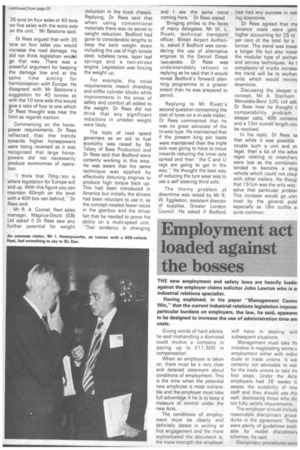egislation calls the tune on design
Page 27

Page 28

If you've noticed an error in this article please click here to report it so we can fix it.
THE GREATEST single influence on truck design according to David Rees, chief engineer of Bedford, is legislation — both known and anticipated. In his paper on heavy truck design for the future, he commented that only the most convincing economic and environmental analyses would lead to higher gross weights in this country.
In the event of higher weights and quite apart from the possible effects of any possible new tax structure, the operational advantages of higher gross carrying weight within the UK would need to be carefully re-assessed if more axles are added to maintain or improve upon current road damage standards.
Speaking for one of the many truck manufacturers in the audience, Mr. J. E. Farley, general sales manager, DAF Trucks (GB) Ltd agreed and subscribed to many of the points raised by Dr Rees but he felt that the 36 ton machine could provide a good compromise. He thought the trend in the UK market was for a truck with a power output in the region of 220/240bhp. He asked what was the logic in proceeding up to 38 tonnes if it involved the use of five axles.
In his reply, Dr Rees said he did not see how it was possible to provide higher efficiency in this weight area while still keeping road damage below the present limit. The logic behind the increase was that the higher the gcw — the greater the efficiency of the operation. But Dr Rees stressed that any increase had to be coupled with putting over an environmental benefit. By adding an extra axle this was possible.
The designer could then ask
himself how high he could go. using that extra axle and still maintain the envirnomental balance. These considerations all intersect at around 38 tonnes, so Dr Rees asked why we should want a 36-ton machine. "Go as high as you can while being environmentally acceptable," Dr Rees told the delegates.
Chief engineer of the National Freight Corporation, Mr W. V. Batstone said he agreed with Mr Farley. He pointed out that with a widespread bogie you could have axle weights of 6, 10, 10 and 10 tons respectively giving 36 tons in total. He knew this was possible with an evenly distributed load but accepted that it was not so easy in practice. Bringing another alternative into the areria, he suggested a four axle combination at 35 tons gcw. Mr Batstone argued that if we continued to use the 10 ton axle, then at 38 tonnes wherever the required extra axle was put, it decreased the payload by around 11/2 tons.
"I don't think this is economical to go from 35 to 38 tonnes and lose 11/2 tons on the way. As I see it we should have
35 tons on four axles or 40 tons on five axles with the extra axle on the unit," Mr Batstone said.
Dr Rees argued that with 35 tons on four axles you would increase the road damage. He did not think legislation wooid go that way. There was a powerful argument for keeping the damage low and at the same time aiming for harmonisation with Europe. He disagreed with Mr Batstone's suggestion for 40 tonnes as with the 10 tone axle this would give a ratio of four to one which Dr Rees thought was near the limit as regards traction.
Commenting on the horsepower requirements, Dr Rees reflected that the trends towards higher horsepowers were being reversed as it was recognised that large horsepowers did not necessarily produce ecomomies of operation.
"I think that 7bhp/ton is where legislation for Europe will end up. With this figure you can maintain 60mph on the level with a 40ft box van behind," Dr Rees said.
Mr R. A. Connal, fleet sales manager, Magirus-Deutz (GB) Ltd asked if Dr Rees saw any further potential for weight reduction in the truck chassis. Replying, Dr Rees said that when using conventional materials there was no secret to weight reduction. Bedford had gone to considerable lengths to keep the kerb weight down including the use of high tensile steel, tubeless tyres, taper leaf springs and a two-stroke engine. Legislation was forcing the weight up..
For example, the noise requirements meant shielding and stiffer cylinder blocks while improvements in the areas of safety and comfort all added to the weight. Dr Rees did not think that any significant reductions in unladen weight were likely.
The topic of road speed governers as an aid to fuel economy was raised by Mr Tebay of Bass Production and Dr Rees said that Bedford were certainly working in this area. He was aware that the same tedhnique was applied by effectively detunirtg engines to produce high torque back up. This had been introduced in America but initially the drivers had been reluctant to use it, as the concept needed fewer ratios in the gearbox and the driver felt that he needed to prove his ability on a multi-speed unit. "That tendency is changing
and I see the same trend coming here," Dr Rees stated.
Bringing smiles to the faces of many delegates, Mr W. L. Rivett, technical transport officer, British Airport Authority, asked if Bedford was considering the use of alternative engines to the Detroit Diesel two-stroke. Dr Rees was understandably reticent in replying as he said that it would reveal Bedford's forward planning programme to a greater extent than he was prepared to permit.
Replying to Mr Rivett's second question concerning the cost of tyres on a tri-axle trailer, Dr Rees commented that he was no great. advocate of the tri-axle type. He maintained that if the present king pin loads were Maintained then the triple axle was going to have to move inwards reducing the inner axle spread and then "the C and U regs are going to get in the way." He thought the best way of reducing the tyre wear was to use a self steering third axle.
The thorny problem of downtime was raised by Mr R. W. Eggleston, assistant dierctor of supplies, Greater London Council. He asked if Bedford had had any success in red' ing downtime.
Dr Rees agreed that ma tenance costs were getti higher accounting for 25 to per cent of the total for a : tonner. The trend was towar a longer life but also towar the modular type of exchan and service techniques. As t
complexity-of trucks increasf the trend will be to exchan units which would minimi downtime.
Discussing the sleeper c; concept, Mr A. Stenham Mercedes-Benz (UK) Ltd ask' Dr Rees how he thought ti compatability problem sleeper cabs, 40ft containe and a 15m overall length cou be resolved.
In his reply, Dr Rees so that while it was possible couple such a unit and st■ legal, then a lot of the adva tages relating to interchanc were lost as the combinatic tended to become a sing vehicle which could not coup with other trailers. He thougi that 151/2m was the only way
solve that particular problen This increase would go unn,
ticed by the general publ especially as 18m outfits al quite common.




















































































